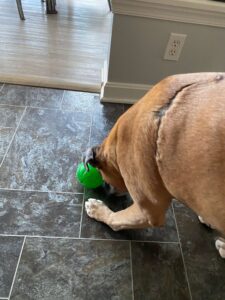This post contains affiliate links. See our Affiliate Disclosure Statement page for more details.
Table of Contents
Are Boxer Dogs Easy To Train?
Are boxer dogs easy to train? To answer this question we put our two rescue boxers to the test and compare our test results to other published research on Boxer trainability. The answer is YES they were easy to train!
Are Boxer Dogs Easy To Train? – Research vs. Study Results
Boxer dogs have been categorized in the literature as a breed that has average/medium working (trainability) and obedience intelligence.
The average/medium working and obedience designation was based on the following ratings after evaluating boxers involved in controlled, monitored training sessions.
- Boxer dogs understand a new command after 25 – 40 repetitions of the command or skill.
- Boxer dogs remember and obey the first command > 50% of the time.
References (Chyan, 2020), Strychalski (2015)
Training and Obedience Criteria
The criteria used for ranking working and obedience intelligence was published in a journal article entitled Design of Purebred Dog Recommendation System using MCDM Approach, Advances in Science, Technology and Engineering Journal, Chyan (2020).
A medium score for trainability
- “A dog can understand a new command with a training frequency of between 16 to 40 repetitions.” A medium core for Obedience
- “A dog can obey 30% or more of a command given every time.” (Chyan, 2020)
In addition, in 2006, Stanley Coren, a dog psychologist, created a list (Check on Amazon Coren’s List ) that illustrated the difference in intelligence between dog breeds.
Coren created his list of dog breeds and their working (trainability) and obedience intelligence based on the criteria used by the American Kennel Club (AKC) and Canadian Kennel Club (CKC) when judging dog breeds.
Trainability is not to be confused with boxer dog intelligence, which we will describe later.
Are Boxer Dogs Easy To Train? Our Boxer Dog Study Results
Discoverboxerdogs.com decided to test our two Adopt A Boxer Rescue Dogs for trainability and obedience to determine if we would produce similar training results to the published research.
Objective: To determine the trainability scores of our two rescue boxer dogs and compare them to published boxer dogs’ trainability and obedience scores.
Test Subjects:
Our Two Rescue Boxers dogs we adopted through Adopt a Boxer Rescue

- Duke
- 9-year-old male boxer who we adopted 8 years ago.
- We adopted Duke after he fell through a trampoline and required 50 staples to close the wound.
- Duke loves treats and will come running if he hears a treat bag being opened.

- Hazel
- A 10-year-old-boxer female we adopted in 2017.
- Hazel was an Amish Puppy Mill Mom and spent 6 years of her life in a crate with no exercise or mental stimulation.
- Hazel loved to eat. When She was at the puppy mill, the opportunities to eat were very limited. Therefore, when food was available Hazel wanted to ensure she got her fair share.
- Sadly, Hazel passed away on May 31, 2022, from Cancer. She was a wonderful, kind-hearted soul who loved to have her belly rubbed.
Visit our Home and Boxer Dog Family pages for more information on Duke and Hazel.
Materials
- Starmark Treat Dispensing Chew Ball Tough Dog Toy, Large Treat Balls purchased at our Affiliate company Chewy.com
- Purina ONE True Instinct Bites With Farm-Raised Chicken Dog Treats, 7-oz bag purchased at our affiliate company Chewy.com
- Cell Phone Camera
Read our Post on Best Treats for Boxers – How To Use Healthy Treats For Good Behavior
Method:
Days 1-3
- We rewarded both Duke and Hazel with 15 small treats for sitting and waiting to get a treat to get them accustomed to the treats and ensuring that both boxers liked the treats.
Days 4-6
- We introduced the empty treat balls and rewarded them with treats if they pushed or moved the treat ball with either their nose or legs.

Day 7 – 9
- We placed an empty treat ball 15 feet in front of them and sat them in front of each Boxer and told them to stay.
- They were given treats each time they stayed sitting without approaching the treat ball so they
- Understood the command to wait before approaching the treat ball.
- Became familiar with the treat ball
Day 10-12
- We filled the treat ball with 15 dog treats. We sat the treat ball 15 feet in front of them and had them sit or stay. If they stayed sitting they were rewarded with a treat.
- We tracked the number of times they sat or stayed without wanting to approach the treat ball. (TASK 1)
Day 12-18
- We filled the treat balls with 15 treats and gave them the command to sit. (TASK 2)
- They were rewarded if they stayed sitting.
- We measured the number of times they stayed seated
- We then instructed them to get the treats from the treat ball. (TASK 3)
- Measured the time it took them to move the treat ball.
- Measured the times they got frustrated and quit before emptying the treat ball.
- Measured the time it took to empty the treat ball.

Measurements:
- The number of times required to get them to remain seated when given the command.
- The number of times required to get them to remain seated when seeing the treat ball.
- The time it took to move the treat ball when given the command to go.
- The times they got frustrated and quit before emptying the treat ball
- The time it took to empty the treat ball.
We also observed:
- If they stayed with their own treat ball or went after the other boxer’s treat ball.
- What would they do if they finished their treat ball first?
The results are summarized in the tables below.
Are Boxer Dogs Easy To Train? Key Finding From Duke’s Treat Ball Trials
- Duke is a 9-year-old male boxer who has been part of the household for 8 years. Because of this fact, Duke is a quick learner who shows he wants to please his family.
- Duke scored very well in understanding and following the first command to sit every time (TASK1). He was able to sit with no commands by Day 3 when the treats were visible.
- (TASK 1) took a little longer to obey the command on Days 10 and 11 when he was distracted with the treat ball when it was visible for the first time.
- Duke was a quick study on (TASK 1) and by Day 14 was sitting on the first attempt
- Duke was able to reduce the time it took to obey the commands (TASK2) from 8 to 0 in 4 days.
- Duke was able to reduce his time to begin moving the treat ball and emptying the treats (TASK 3) from Day 13 to Day 18. Day 16 was trash and recycling pick-up day and Duke was distracted by the trucks in front of the house.
- Distractions can disrupt the training process. for Duke
Boxer Dog DUKE
| (TASK 1)
| (TASK 2)
| (TASK3)
| (TASK3)
| (TASK3)
|
10 | 2 | 8 | NA | NA | NA |
11 | 1 | 6 | NA | NA | NA |
12 | 0 | 2 | NA | NA | NA |
13 | 0 | 1 | 4 seconds | 0 | 1 min 53 secs |
14 | 0 | 0 | 4 seconds | 0 | 1 min 39 secs |
15 | 0 | 0 | 2 seconds | 0 | 1 min 27 secs |
16 | 1 | 1 | 2 seconds | 1 | 2 min 8 secs |
17 | 0 | 0 | 1 second | 0 | 1 min 18 secs |
18 | 0 | 0 | 1 second | 0 | 1 min 6 secs |
Are Boxer Dogs Easy To Train? Key Findings from Hazel’s Treat Ball Training

- Hazel’s results showed that it took more repetitions for her early on in the study to grasp the command, but she showed significant improvement as the study progressed.
- Hazel’s background as a puppy mill dog may have played a significant factor in learning a new command. She spent over 6 years in a crate with little or no mental or physical stimulation.
- Hazel, like Duke, wanted to please the family, and once she grasped the concept was quick to sit on command, especially when treats were visible.
- Hazel initially took longer to push the treat ball but once she realized there were treats inside she dramatically decreased her time to move the ball.
- Hazel, once she was locked onto the treat ball and the treats inside did not get frustrated or walk away from the treat ball until it was empty.
- Hazel showed the greatest improvement in time to empty the treat ball between the two boxer dogs. This may be attributed to Hazel’s upbringing as a puppy mill dog and the food scarcity she endured. Therefore, once she had access to the treats she wanted to ensure she got her fair share.
Boxer Dog Hazel
| (TASK 1)
| (TASK 2)
| (TASK 3)
| (TASK 3)
| (TASK 3)
|
10 | 18 | 21 | NA | NA | NA |
11 | 17 | 18 | NA | NA | NA |
12 | 13 | 15 | NA | NA | NA |
13 | 8 | 11 | 8 seconds | 0 | 2 min 20 secs |
14 | 5 | 9 | 4 seconds | 0 | 1 min 57 secs |
15 | 4 | 7 | 2 seconds | 0 | 1 min 26 secs |
16 | 2 | 5 | 1 second | 0 | 1min 13 secs |
17 | 1 | 4 | 1 second | 0 | 1 min 2 secs |
18 | 1 | 4 | 1 second | 0 | 58 secs |
For an additional discoverboxerdogs.com owner study on Boxer Dog Behavior, read our post on Do Boxer Dogs Bark A Lot?
We use and recommend the following two treat balls for training. They are sturdy and easy for the dogs to use.
Starmark Treat Dispensing Chew Ball Tough Dog Toy
Starmark Treat Dispensing Bob-a-Lot Dog Toy
For post-training rewards, we like to give them these healthy treats
3 Pack – Superfood Dog Treats with Koji (5 oz per bag) from Wild Earth
Chicken and Apple Treats from Ollie Pet Food
Are Boxer Dogs Easy To Train? Additional Observations
- Duke had a quicker grasp of the commands and tasks than Hazel. This may be due to the fact that he has lived in the house longer than Hazel and is more accustomed to following commands.
- The limitations of this study make it hard to determine if there is a difference in the trainability of male vs female boxer dogs. Additional studies with a more focused design would be needed.
- Background played a big role in trainability. Hazel because of her food scarcity background did not stop trying to get treats until all the treats in her treat ball were empty.
- Duke was more methodical in his efforts to empty the treat ball. He moved the ball at a constant pace until the treat ball was empty.
- Both Boxer dogs would push the ball into difficult places behind furniture but would find a way to dislodge the training ball and continue until it was empty.

Are Boxer Dogs Easy To Train? Boxer Dog Behavior
What did the boxer Dogs do when their Treat Ball was empty?
- Duke walked away from the treat ball when its contents were gone and went and laid down.
- Hazel, because her treat ball was often empty would follow Duke around and try to get any treats that Duke missed. She would often check his treat ball for treats after Duke was finished.
- Duke was more easily distracted by outside noises, such as delivery trucks or lawn services at neighboring houses.
- Hazel was hyper-focused on the treats and would only follow Duke to the window to bark at Delivery trucks when her treat ball was empty.
Summary
Our in-home, boxer dog owner study produced results that mirrored the published research. While Duke produced results that were above average, Hazel’s results were in line with published research.
The average of the two results showed that Boxer Dogs have medium trainability and obedience.
It is important to note that trainability and obedience are different than intelligence, which we will cover in great detail in a future post.
Our overall assessment is that YES, Boxer dogs are easy to train.
Enjoy the training process with your Boxer dog, you will be impressed with their abilities.

Discoverboxerdogs.com are Mary and Chris Kustanbauter. We reside in Red Lion, PA with our two Boxers, Duke and Katie, who are both rescue dogs. We have been working with Adopt A Boxer Rescue for the past 17 years and have adopted 5 Boxers from this fine organization. To learn more visit our Home, Boxer Dog Family, and Blogs Pages Visit us on social media on Facebook – All About Boxers, Instagram, and Pinterest.


